"St. Anthony died from edema in 1231, and when he was exhumed in 1263 he had totally decomposed, except for, curiously, his tongue. The tongue was reportedly just as wet and incorrupt as it had been in his life, when he was celebrated for his oratory skills. He spent most of his life roaming Italy and France, giving sermons that captivated all of his audiences with a gripping power. He was canonized not too long after his death, but it was 30 years later when he was dug up to be reburied in a new basilica that his miraculous tongue was discovered. Now the tongue, as well as his jaw bone, are both displayed in the Basilica of Saint Anthony of Padua in elaborate gold reliquaries. The rest of his remains are entombed in a separate chapel. The 13th-century church itself is an incredible sprawl of architectural styles topped by some Byzantine domes. Inside, in addition to the relics, are stunning sculptures by Donatello and a famous 14th-century fresco by Giotto. However, most come to venerate St. Anthony, who is the patron saint of lost things, in the hopes he might help them find what they’re looking for." - ATLAS_OBSCURA




